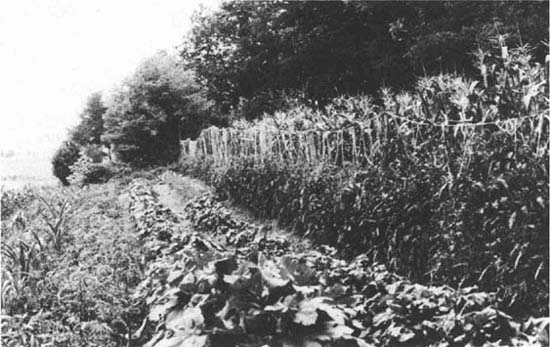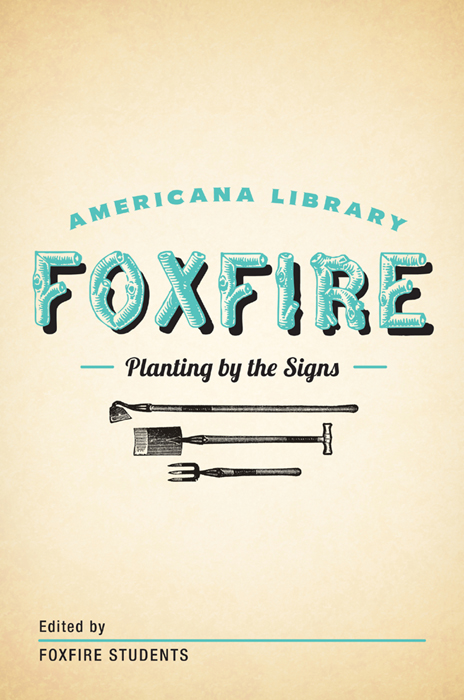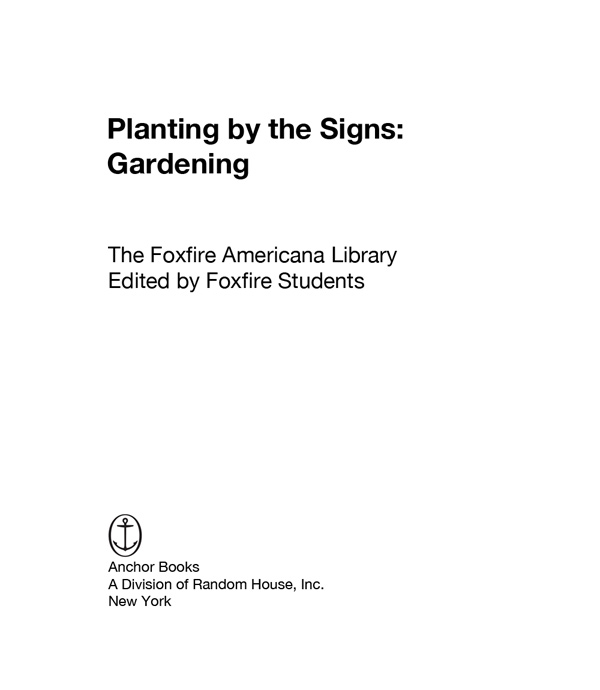ANCHOR BOOKS EDITION, SEPTEMBER 2011
Copyright 1972, 1977, 2011 by the Foxfire Fund, Inc.
All rights reserved. Published in the United States by Anchor Books, a division of Random House, Inc., New York.
Anchor Books and colophon are registered trademarks of Random House, Inc.
Gardening originally appeared in Foxfire 4, 1977 by The Foxfire Fund, Inc. Reprinted by permission of Random House, Inc.
Weather Signs and Planting by the Signs originally appeared in The Foxfire Book, 1972 by The Foxfire Fund, Inc. Reprinted by permission of Random House, Inc.
Raising Native Azaleas from Seed originally appeared in The Foxfire 45th Anniversary Book, 2011 by The Foxfire Fund, Inc. Reprinted by permission of Random House, Inc.
eISBN: 978-0-307-94829-8
v3.1
Table of Contents
A NOTE ABOUT THE FOXFIRE AMERICANA LIBRARY SERIES
For almost half a century, high school students in the Foxfire program in Rabun County, Georgia, have collected oral histories of their elders from the southern Appalachian region in an attempt to preserve a part of the rapidly vanishing heritage and dialect. The Foxfire Fund, Inc., has brought that philosophy of simple living to millions of readers, starting with the bestselling success of The Foxfire Book in the early 1970s. Their series of fifteen books and counting has taught creative self-sufficiency and has preserved the stories, crafts, and customs of the unique Appalachian culture for future generations.
Traditionally, books in the Foxfire series have included a little something for everyone in each and every volume. For the first time ever, through the creation of The Foxfire Americana Library, this forty-five-year collection of knowledge has been organized by subject. Whether down-home recipes or simple tips for both your household and garden, each book holds a wealth of tried-and-true information, all passed down by unforgettable people with unforgettable voices.
GARDENING
A ll my life I had heard talk of, and even watched my family make, a garden. But because I was younger and the grocery store was just down the road, I never felt that I should go out in the hot sun and hoe the garden. Suddenly last year the fact that I was going to have to plant a garden dawned on me. The first thing that came to my mind was, I dont know anything about a garden. Thats when I started working on this article.
My first question was why did they plant a garden? Esco Pitts, one of our contacts, said, Then you couldnt just go to the store and buy much stuff, cause they wasnt much stuff to buy. And the people just made their living, just got the practice of making their living at home.
And thats just what they did. The women would take care of the vegetable garden. Mr. Pitts recalled, My mother would always put one row of flowers in the middle of the garden. She took care of them just like she did the vegetables.
What did the men do? They took care of the field cropsthings like two acres of corn or wheat. The corn was saved to take to the mill for their cornmeal and the wheat was made into flour. Sometimes they grew cane for cane syrup, which could be used in the place of sugar.
Yes! People really did get out and work in the field. And if you got sick and couldnt work, you didnt worry about it much because some of the folks that lived near would come over and help. Aunt Arie said, People wasnt ascared of each other, like they are now. All the people far and near would gather at one house. They would have a barnraisin or bean-stringin or cornshuckin. The families would all bring food and after the work was done, all would eat and talk. Lawton Brooks said, We had a many a cornshuckin way back yonder, but no more.
After getting the land ready and planting the seeds came watching it grow and keeping the animals out and the bugs off. Finally came the harvest. That was the time when everybody worked. They worked not only to gather it, but to store it for use during the winter. The mother would can the vegetables and dry the fruit. The father had to bury the things like potatoes and cabbage. He buried them to keep them from freezing. Florence Brooks said, You could go back in the dead of the winter and dig out a cabbage and it would be just as good as the day you cut it.

I LLUSTRATION 1 Ednie Buchanans vegetable garden.
The people raised their pork and beef, so they didnt have to buy much. They only bought what they couldnt grow, going to market about twice a year. A family would raise enough vegetables to have some left to sell after putting up what they needed for the family. Kenny Runion remembered, We loaded up the wagon and it was so far [to market] that we would have to camp on the way there or back.
When they sold the vegetables, they would buy their supplies consisting of pepper, salt, some seeds, and coffee beans. Mr. Pitts commented, Ive woke up many amorning to the smell of coffee beans roasting on the fireplace.
After about ten or fifteen interviews I found that I had not only learned how to plant a garden, but I had gained a small amount of understanding of what life was like thirty or forty years ago.
MARY THOMAS
Interviews and transcriptions by Bit Carver, Mary Chastain, Vicki Chastain, Susie Nichols, Cheryl Stocky, Mary Thomas, and Terese Turpin.
Organization and editing by Mary Thomas and Lynnette Williams. Photography by Brenda Carpenter, Myra Queen, Annette Reems, Barbara Taylor, Mary Thomas, and Lynnette Williams.
CLEARING THE LAND
Families in the mountains generally settled on land that had not been previously homesteaded. They, therefore, had to build their homes and clear their land for farming using only simple tools, manpower, and ox-power. To cut the trees, many of them two and three feet in diameter, they had only large two-man crosscut saws and axes. They chose the levelest, richest-looking land, and cleared that for their crops. This was very important, because those mountaineers were not gardening casually; they were, of necessity, farming for their survival.
R. M. DICKERSON: All this country, this bottom land here where we see it now, in my fathers and mothers day and my grandfathers day, was in a swamp. It was growed up in woods. And the first settlers here settled around the foot of the hills above the swamp. The swamp was full of water and you couldnt do any good down there until it was drained out, so they first settled around the edge of the mountains and up on the mountains. They cleared the land there and got the logs and built log houses; thats the kind of house I was raised ina log cabin. They built those log cabins out of logs that they took off the land they was going to cultivate. They took those logs and used this kind of tractor [a horse and sled] and skidded them up to where they was going to build a house.
They [sawed] the trees down on thplace and cutem up. The ones that they was going to use, they rolled them over to the side. But they rolled the old rough logs and the stuff that was too big for a house log, they rolled that up and builtem a fire and burnedem all up in the brush. Sometimes it would take two or three days to burn all the logs. Theyd just keep rollin the logs together till they gotem burnt up.




